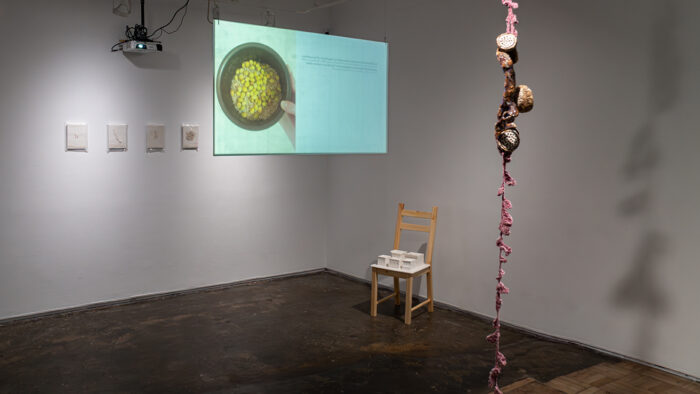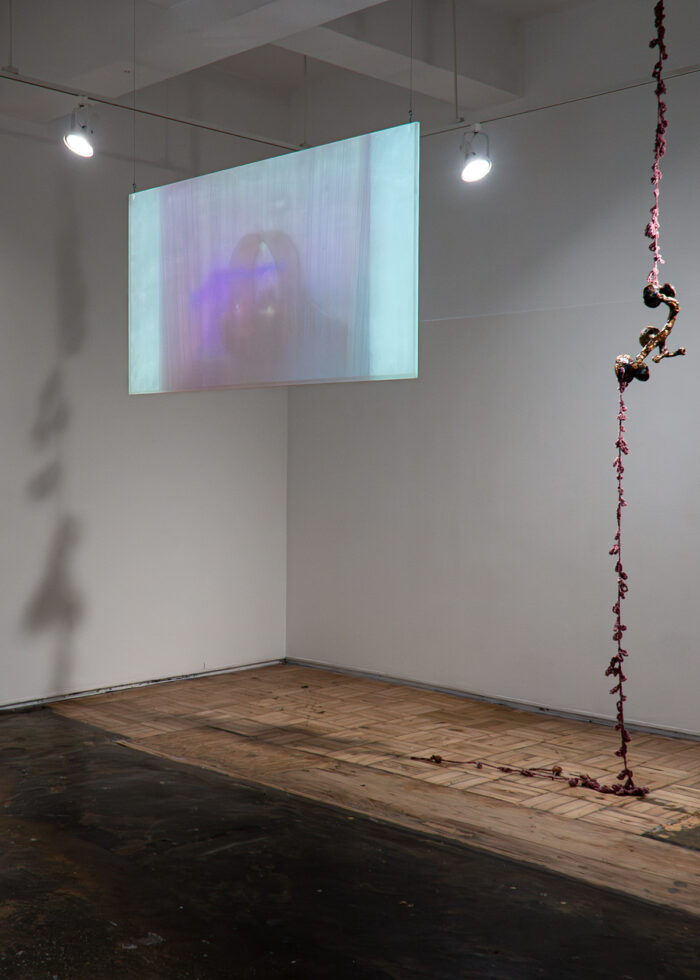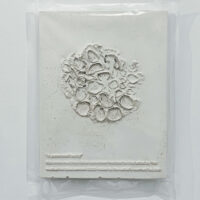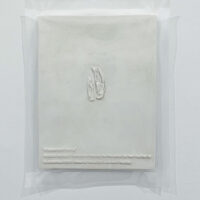In June 2023, Bonam Kim and Lu Zhang started a conversation and exchange that originated as part of the project “The Faraway Nearby,” curated by Jiyeon Paik and to be presented in February 2024 at A.I.R. Gallery in N.Y.C. In this project, Paik invited four artists to, in turn, invite another four artists to collaborate and think together of themes related to identity, belonging, home, health, and politics. The initial conversation between Kim and Zhang revolved around the idea of home and migration and organically evolved into an exchange about plants, care, and health. Throughout this process, Kim and Zhang have been able to exchange knowledge while deepening their friendship. Although not fully recorded, each conversation between the artists has left accounts in the form of jotted notes, images, photographs, recipes, and memories, all available on a website created by the curator of this project.[2]

Since Kim’s arrival in N.Y.C., her mother has consistently sent “care packages.” They include an array of home products primarily focused on health and related to herbal medicine–home remedies to strengthen the immune system, clear the lungs, or cure other common ailments. These are medicines for the body but also symbolize care and connection to a home 6,965 miles away. For this project, Kim has started looking at the products in care packages methodically, specifically at the plants, to create a sort of inventory or encyclopedia of care. In the exhibition space[3], Kim presents the first five plaster plates of what will one day be a comprehensive catalog of products she plans to record in the same technique: through reliefs in a letter-sized plaster plate with a description that evokes the plant and its relationship with the artist in a scientific and taxonomic language.
Bonam Kim, 9 Years Well Being, 2024. Image courtesy of Bonam Kim.
The initial inventory includes jujube, lotus root, burdock, and morel and reishi mushrooms. Each piece contains a description that establishes how the particular rendered plant or object was sent by the artist’s mother and traveled the distance from Seoul to New York to be integrated into the artist’s habitat. In each piece, Kim refers to herself and her surroundings in terms of “subject,” “specimen,” and “habitat.” Thus, Kim places herself as the Other—the observed and studied object/subject whom a foreign entity or outsider describes. The layers beneath Kim’s work, referring to herself in the third person, create a distance from the object. The separation is accentuated by the vacuum-sealed plastic bag in which every piece (both in the care package and the gallery) is contained in an attempt to preserve and protect its content. Its geometrical organization on the gallery wall evokes carefully packed samples and materials for further study. Although arranged and presented methodologically, Kim’s 9 Years Well Being (2024) mainly records her and her mother’s connections and care relationships. This artwork is also an exercise in memory-keeping and an exploration of the experience of alienation and displacement. Still, most importantly, it is one of the ways in which the artist continues to be connected, in relationships of care, to her home country– a recurrent concern in Kim’s work.
Similarly, throughout this process, Lu Zhang has evoked plants as one of the main connectors between her and her grandparents, who passed away recently. Zhang has been keeping and caring for the same types of plants in N.Y.C. that her grandparents cared for back in China. Throughout her conversations with Kim, Zhang has also evoked her relationships with herbs and medicinal plants, particularly those related to women’s health. For the exhibition presentation, Zhang focuses on the lotus flower and its parts as independent sources of medicinal remedies. Besides its strong connotation with Buddhism and as a symbol of luck and togetherness, the lotus has been incorporated into health practices in many forms. The leaves, for instance, are known for their calming effect on the nerves and their ability to enhance concentration. The lotus root cools inner fires and bad tempers and effectively reduces inflammation or bleeding. The part between the leaves and the stem, called lotus house, is used to help clean the uterus after a baby’s birth. Lotus leaves can also tame the thirst, calm both a pregnant mother and her baby, and aid in producing new blood in the body. Its infused seeds are a common fall remedy for sore throat, and their bitter parts, or plumule, are good for heart health. Thus, every part of the lotus flower serves a purpose.

In the gallery space, Zhang’s Exiting From the Mud (2024) mixes ceramics and velvet yarn to evoke a poetic approach to health and spiritual well-being in the form of an incense burner. The position of the intricate work in the space recalls ancient Song and Han Dynasty illustrations where the Buddha gently holds the lotus flower with their entire palms and forearm. The position of the figure in the space evokes, thus, a virtual presence holding the ceramic piece while the light heightens the bright purple, brown, yellow, and blue tones emanating from it.
In past years, Zhang’s work has been marked by an interrogation of presence, absence, and simultaneity, as well as the existence of parallel spaces. This inquiry has been prompted and explored through a dialogue between digital images –originated in Facetime conversations, Zoom meetings, and other forms of human connections through technology– and material explorations, including ceramics, painting, and installation, prompting ideas related to a double life or reality, and the evocation of multiple centers in unison.
Throughout this collaboration, Kim and Zhang have summoned flowers, plants, and herbs as surrogates for a connection with home and as symbols of care. Their process and resulting works in the gallery space also testify to Mexican sociologist Guillermo Bonfil Batalla’s observation of the broad symbolic significance and the therapeutic effect of natural medicinal products and their use within a symbolic and emotional context with cultural meaning.[4] Moreover, Kim and Zhang bring to this conversation an analytical regard that dissects the plants they engage with in a desire to understand each part, how it can contribute to overall health, and as an intimate gesture that interweaves close knowledge and affection. Thus, they create an inventory in which categories expand to the material properties and their significance and coincide in summoning the notion of touch (or the lack of it).

During their extended dialogue, Kim and Zhang also spoke about their migration to the United States, the ever-changing meanings of home, notions of belonging, and spirituality. Among the photos gathered on the project’s website, the image of a temple where Kim’s grandmother’s mortuary tablet remains caught my attention. Kim describes this place as a significant one for her family. Zhang evokes it in a conversation as a place full of wishes threaded in the trees and as a protective spiritual space, underlining the idea of the thread as a metaphor for life. This idea is strongly echoed in Zhang’s work, where the brown tones of the incense burner evoke soil, suggesting the possibility of the work being recently disinterred from the earth and the crochet strain as an umbilical cord or thread of life connecting the piece above and below. In Kim’s 9 Years Well Being, the sequence of the works interweave a connection, first with her mother, but also with her ancestors, as a larger study that, more than unveiling habits, uncovers ancient practices filled with meaning which, as writer Olivia Teroba says, “move through time: [as] other women in [their] family have carried them out.”[5]
Both Kim and Zhang have evoked ancient practices filled with meanings, but more importantly, filled with a sense of continuity that has not only allowed them to recreate their own “home” landscapes but also to understand that the ways in which these practices are maintained and cultivated are through sharing, friendship, and complicity.
[1] The title of this text is borrowed from the conversations between the artists.
[2] https://thefarawaynearby.us/Bonam-Kim-Lu-Zhang
[3] A.I.R Gallery, February 26–March 3, 2024
[4] Bonfil Batalla, Guillermo. México profundo: una civilización negada. Fondo de Cultura Económica, 2020. 34. (My translation)
[5] Teroba, Olivia. Gerber, Verónica, editora. En una orilla brumosa. Personas Mirando el Cielo. Gris Tormenta, 2021. 133. (My translation)





